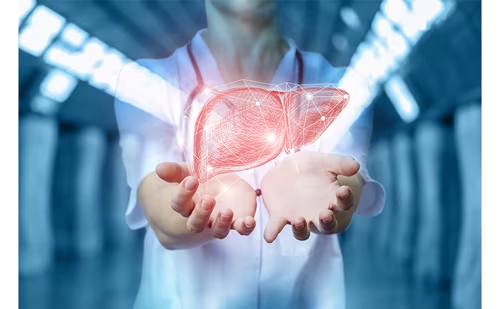Liver conditions are often misunderstood, mischaracterized and stigmatized, which results in under-diagnosis, under-treatment and unnecessarily poor outcomes worldwide. The Global Liver Institute (GLI) “Liver Health is Public Health” initiative aims to respond to this unmet need and educate the public about liver health and disease prevention. In this expert interview, Donna Cryer discusses the misconceptions that persist around liver conditions, how these can be overcome, as well as how the “Liver Health is Public Health” initiative aims to address on-going challenges to shift the conversation on liver health.
Q. How does the Global Liver Institute help support patients and endocrinologists?
GLI’s mission is to improve the lives of individuals and families impacted by liver disease through promoting innovation, encouraging collaboration and scaling optimal approaches to help eradicate liver diseases. Many liver diseases, particularly nonalcoholic fatty liver disease (NAFLD) or nonalcoholic steatohepatitis, are frequently associated with diabetes and other metabolic disorders. Thus, endocrinologists need to be aware and up to date on the latest guidelines, clinical pathways and barriers that patients face when receiving care. GLI has consistently partnered with leading endocrinologists and endocrine organizations, such as the American Association of Clinical Endocrinology and the Endocrine Society, to co-create educational material and align agendas.
GLI helps patients by supporting their endocrinologists while empowering patients to advocate for themselves, and others in the clinic and their communities. GLI also supports patients in front of policymakers via training and opportunities through the Advanced Advocacy Academy (A3)1 as well as joint advocacy with our Liver Action Network.2
Q. What are the aims of the “Liver Health is Public Health” initiative?
Every human body has a liver, therefore, all individuals should be informed and equipped to take action to promote liver health. GLI’s “Liver Health is Public Health” initiative is a direct response to the fact that liver conditions are stigmatized and misunderstood, which results in under-diagnosis, under-treatment and unnecessarily poor outcomes worldwide.3 To counter this, we will need to broaden the circle of activists and organizations engaged in liver health activities, align with successful public health efforts and leverage all public health tools; that is, food policy, environmental policy, behavioural science, as well as drug, device, and diagnostic innovation.
Q. What activities and resources will be available as part of the “Liver Health is Public Health” initiative?
In GLI’s mission to elevate liver health to its rightful place on the global public health agenda, the initiative will educate community members, healthcare providers and policymakers about liver health and disease prevention. The initiative will pave the way for best practices that account for differences in: stage of disease, patient preferences, values, culture, language, geography and socioeconomic environment.
During 2022, its pilot year, the initiative launched two valuable resources: a series of educational brochures about liver health and the Global State of Liver Health report.4
The first resource launched was the Liver Health Basics booklet, which provides a foundation for understanding liver health.5 It covers the function of the liver, common symptoms and types of liver diseases, drivers of liver disease (including diabetes and related conditions) and outlines positive liver habits. Specialists, such as endocrinologists, are encouraged to share this booklet with their patients, to encourage a baseline understanding of liver health. This is the first in a series of educational brochures targeting different audiences including patients, caregivers, primary care providers, non-hepatology specialists and more.
The Global State of Liver Health report defines and analyses the landscape of liver health worldwide.6 It draws from available epidemiological studies and the perspectives of locally based experts, such as hepatologists, gastroenterologists, endocrinologists, liver patient advocates and disease control programmes. The report is both a foundational resource and a rallying cry for clinicians, policymakers, patient advocates and other community leaders to fight liver disease.
In 2023, GLI is developing further pieces of educational resources for the general public, policymakers, payers and provider audiences. Our team is expanding and updating the Global State of Liver Health report with deep dives into additional countries.
Q. What misconceptions persist around liver conditions and how can these be overcome?
One of the most common misconceptions related to liver diseases is that they are instantly associated with alcohol or drug use. However, obesity is another driving cause of liver disease, which is unfortunately another condition that carries stigma.
It is still believed that patients with diabetes are not susceptible to liver disease, even though a strong, bidirectional relationship exists between the two conditions. Around 70% of people with type 2 diabetes have NAFLD, and the prevalence of diabetes among people with NAFLD is 2.5 times higher than in the general population.7,8
GLI are committed to on-going, transparent conversations about liver health that deconstruct the stigma around liver diseases and ensure the needs of patients with liver diseases are heard and accounted for.
Q. How will this programme address on-going challenges, and shift the conversation on liver health?
It is critical for every single individual to recognize the liver, learn more about it and know how to keep it functioning well. Many know the function of the heart, lungs, brain or stomach, yet many would have difficulties explaining what the liver does. The “Liver Health is Public Health” initiative will simultaneously boost public understanding of the liver and encourage health experts across the breadth of specialities to join the discussion in order to collectively shift global attention.
Q. How can people get involved?
We invite everyone to get involved. This includes doctors who are caring for patients as well as participating in seminars and panels to share the latest updates in the field. We also invite scientific societies worldwide to endorse the initiative, as well as partnering organizations hosting awareness and educational events, and individuals who are eager to learn about the liver and share vital information. Eventually, we hope that policymakers can join the conversation and take part in prioritizing liver health as a key component in the public health agenda.
You can learn more at: www.globalliver.org/liver-health-is-public-health/






